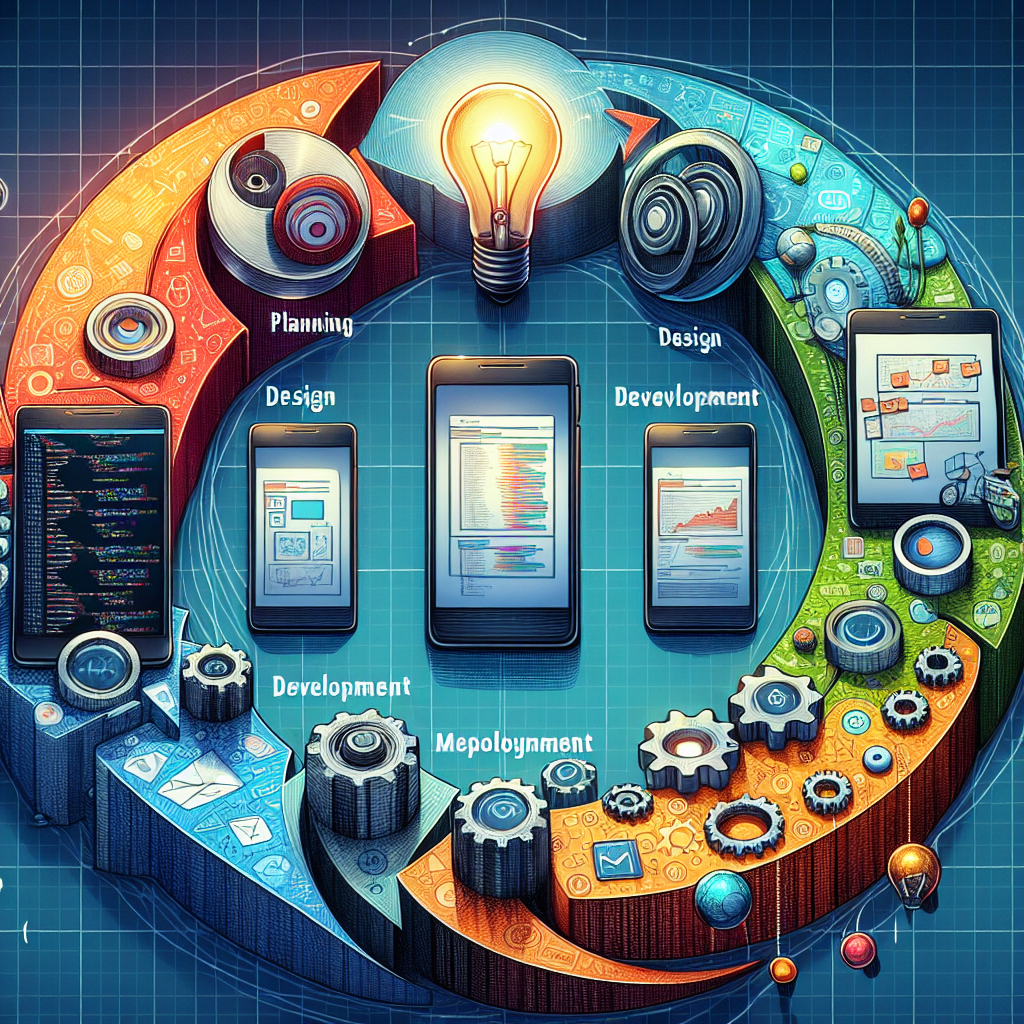The mobile application development life cycle is a crucial framework that guides developers and stakeholders through the intricate process of creating mobile applications. Understanding this life cycle is essential for both technical and non-technical individuals involved in app development.
Typically, the life cycle consists of several phases, including:
- Planning: This phase involves defining the app’s purpose, target audience, and key features.
- Design: In this stage, the user interface (UI) and user experience (UX) are crafted to ensure an intuitive and engaging experience.
- Development: Coders bring the design to life by writing the app’s code, integrating features, and ensuring functionality.
- Testing: Rigorous testing is conducted to identify and fix bugs, ensuring a smooth user experience upon launch.
- Deployment: The app is released on various platforms, such as the Apple App Store or Google Play Store.
- Maintenance: Post-launch, developers continue to improve and update the app based on user feedback and performance analytics.
Recognizing the significance of each phase can significantly impact the success of an app. It helps in optimizing resources, managing timelines, and reducing costs. If you’re looking to navigate the complexities of mobile application development, Book A Consultation Now! to gain insights tailored to your needs.
Understanding Each Phase of the Development Life Cycle

Every phase of the mobile application development life cycle plays a pivotal role in ensuring that the final product meets user expectations and business goals. Let’s delve deeper into each phase:
- Planning: This is the groundwork of the entire development process. It involves gathering requirements, conducting market research, and defining the scope of the app. Clear goals and objectives are set during this phase, determining the direction of the project.
- Design: The design phase focuses on both UI and UX. Designers create wireframes and prototypes to visualize the app’s layout and flow. This phase aims to ensure that the app is not only aesthetically pleasing but also user-friendly, enhancing user engagement.
- Development: This phase is where the app truly comes to life. Developers write the code, implement functionalities, and integrate various features as per the design specifications. This process may involve both front-end and back-end development, depending on the app’s complexity.
- Testing: Before launching the app, extensive testing is essential. This includes functional testing, performance testing, and usability testing. The goal is to identify and rectify any issues to ensure the app functions smoothly across devices and platforms.
- Deployment: Once the app passes all testing phases, it is deployed to the app stores. This phase also includes preparing marketing materials and strategies to promote the app effectively.
- Maintenance: After deployment, the app requires ongoing maintenance to address bugs, incorporate user feedback, and implement updates. This ensures that the app remains relevant and continues to meet user needs over time.
Understanding these phases not only streamlines the development process but also enhances communication among teams, ultimately leading to a successful mobile application.
Importance of Planning and Design in Development

The foundation of any successful mobile application lies in the initial stages of planning and design. These phases are critical in shaping the future of the application and determining its success in the competitive market.
During the planning phase, developers and stakeholders come together to outline the app’s objectives, identify the target audience, and conduct in-depth market analysis. This research is vital as it helps to:
- Identify User Needs: Understanding what users expect from the app enables developers to create features that cater to their preferences, ensuring a higher adoption rate.
- Set Clear Goals: Establishing measurable goals provides a roadmap for the project, allowing teams to stay focused and aligned throughout the development process.
- Allocate Resources Efficiently: Proper planning allows for better budgeting and resource allocation, preventing potential setbacks and ensuring that the project runs smoothly.
Following planning, the design phase is equally essential. It encompasses the visual and functional aspects of the app, ensuring that it is not only appealing but also user-friendly. Key elements of the design phase include:
- User Interface (UI): A well-designed UI captures user attention and enhances their interaction with the app, making it intuitive and engaging.
- User Experience (UX): Focusing on the overall experience ensures that users can navigate the app effortlessly, which significantly impacts user satisfaction and retention.
- Prototyping: Creating prototypes allows stakeholders to visualize the app and gather feedback early in the process, facilitating necessary adjustments before development begins.
In summary, the importance of planning and design cannot be overstated. These initial stages set the tone for the entire development process, directly influencing the app’s viability and success in a crowded marketplace.
Development and Testing: Key Stages Explained

Once the planning and design phases are complete, the next significant stages in the mobile application development life cycle are development and testing. These stages are crucial for transforming your app idea into a functional product.
The development phase involves the actual coding of the application. Developers use various programming languages and frameworks tailored to the specific platform—whether it’s iOS, Android, or cross-platform. Key activities during this phase include:
- Front-end Development: This is where the visual elements of the app come to life. Developers create the user interface, ensuring it aligns with the design specifications and provides a seamless user experience.
- Back-end Development: This part focuses on the server-side of the application, including databases, server logic, and application programming interfaces (APIs). It ensures that the app functions smoothly and can handle user requests efficiently.
- Integration: Developers integrate various components and third-party services, such as payment gateways and analytics tools, enhancing the app’s functionality.
Once the development is underway or completed, the testing phase begins. This phase is critical for identifying and rectifying any bugs or issues that may hinder the app’s performance. Testing can be categorized into several types:
- Functional Testing: This ensures that all features work as intended and meet the specified requirements.
- Usability Testing: This checks the app’s user interface and experience, verifying that it is intuitive and user-friendly.
- Performance Testing: This assesses how the app performs under various conditions, such as heavy traffic or low connectivity, ensuring it remains reliable.
- Security Testing: This is crucial in identifying vulnerabilities that could compromise user data and ensuring that the app complies with necessary security standards.
In summary, the development and testing stages are where your app’s concept transforms into reality. By focusing on these key stages, you can ensure that your application is not only functional but also ready to meet the needs of its users.
Launching Your Mobile Application Successfully
After the rigorous development and testing phases, the next critical step in the mobile application development life cycle is the launch. A successful launch can significantly impact your app’s visibility and user acquisition, making it essential to strategize effectively.
Before launching, it’s pivotal to conduct a thorough review of the app to ensure that it meets all quality standards and is free of bugs. Once you are confident in your app’s readiness, consider the following key aspects for a successful launch:
- Choose the Right Launch Date: Timing can play a crucial role in your app’s initial success. Research industry trends, avoid competing releases, and aim for a date that maximizes visibility.
- Prepare Marketing Materials: Create eye-catching graphics, videos, and promotional content that highlight your app’s unique features. This content can be used across various platforms, including social media, blogs, and press releases.
- Optimize App Store Listings: Ensure your app is optimized for app store visibility by using relevant keywords in the title and description. High-quality screenshots and an engaging app preview can significantly boost downloads.
- Leverage Social Media and Influencers: Promote your app through social media channels and consider collaborating with influencers who align with your brand. Their reach can introduce your app to a wider audience.
- Plan for User Feedback: Encourage users to provide feedback and reviews. Early user insights are invaluable for understanding how your app performs in real-world conditions and can inform future updates.
Once your app is live, monitor its performance closely. Use analytics tools to track user engagement and retention rates. This data will help you make informed decisions about future updates and marketing strategies.
Launching your mobile application is not just about making it available; it’s about ensuring that it reaches its target audience effectively. By focusing on these strategies, you can significantly increase the chances of your app achieving long-term success in a competitive market.
Post-Launch Strategies for App Success

After successfully launching your mobile application, the journey doesn’t end there. In fact, it marks the beginning of a crucial phase where post-launch strategies play a significant role in determining the long-term success of your app. Focusing on the right tactics can help you retain users, enhance their experience, and drive continuous growth.
Here are some effective post-launch strategies to consider:
- Enhance User Engagement: Keep your users engaged by regularly updating your app with new features, improvements, and content. Listen to user feedback to understand their needs and expectations.
- Implement Analytics: Utilize analytics tools to track user behavior, app usage patterns, and retention rates. This data is essential for making informed decisions about future updates and marketing campaigns.
- Foster a Community: Create a user community around your app. Engage with users through social media, forums, or in-app messaging. This fosters loyalty and makes users feel valued.
- Run Marketing Campaigns: Continue to promote your app through targeted marketing campaigns. Consider using email marketing, social media ads, and influencer partnerships to reach new audiences and re-engage existing users.
- Gather Feedback and Iterate: Encourage users to provide feedback on their experience. Use surveys and in-app prompts to gather insights, which will help you refine your app and address any issues promptly.
By implementing these strategies, you can create a dynamic app that adapts to user needs and market trends. This proactive approach not only improves user satisfaction but also enhances your app’s reputation in the competitive app landscape.
If you’re looking for tailored advice on how to implement post-launch strategies effectively, Book A Consultation Now!
